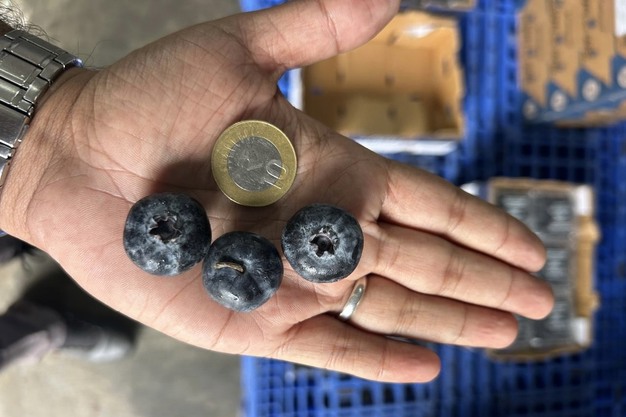Blueberries have become an increasingly familiar sight in India, with supplies now flowing throughout the year, says Karan Parashar, Director of fresh produce importer Exotic Imports Pvt. Ltd. "The Indian blueberry season begins every January and goes on till April end, with a range of zero-chill and low-chill varieties from Fall Creek, Planasa and some other breeders grown across farms of central and northern India."
 © ITG Exim Pvt Ltd
© ITG Exim Pvt Ltd
As the local crop ends, imports begin in May, filling the gap until domestic production resumes. Parashar explains, "That's Peru's off-season, but some high-altitude farms there continue harvesting, which helps us fill the gap." Currently, Exotic Imports imports around 8 to 10 tons of fresh blueberries weekly by air into Delhi and Mumbai, bringing in Planasa's Malibu, Manila, and Madeira, as well as Fall Creek's Emerald and A-blues, along with some Sekoya varieties from Peru, the Netherlands, Poland, and Georgia.
While the fruit quality at the source is usually excellent, Parashar mentions that the challenge is getting the fruit into India in the same fresh condition. "Multiple stops and expensive air freight often disrupt the cold chain, affecting the berries' look and crunch. Single-stop flights, which help maintain quality, are extremely expensive and scarce." He highlights the advantage of sourcing through the Netherlands: "Sometimes it makes more sense for our Netherlands-based partners to consolidate and supply fruit from various origins for better pricing and volumes."
 © ITG Exim Pvt Ltd
© ITG Exim Pvt Ltd
According to Parashar, "Prices have softened recently due to increased global production, especially in Peru, with its output rising by 25-30% this season. However, growers are adapting pricing based on destination markets in contrast to previous years, where prices were fixed."
Looking ahead, Parashar shares that South Africa could become a new source to offer shorter transit times if Indian quarantine approvals come through. "While Chile remains an open source, it mainly produces high-chill varieties that do not handle long-distance transits well. But Biloxi and other Planasa and Sekoya varieties grown in Chile can do well in India."
 © ITG Exim Pvt Ltd
© ITG Exim Pvt Ltd
Parashar shares plans to expand bulk imports via container shipments for modern trade and tier 2 and 3 cities. "We're working on getting containers directly from Peru next year, aiming to reduce costs and increase reach." He estimates India's annual blueberry production to be at 400 to 600 tons, with some large projects of over 50 acres in Madhya Pradesh and Uttarakhand partnering with international growers for patented varieties.
Once the domestic season starts in January, imports will once again slow down. "When local fruit returns, Indian blueberries can be sold at lower prices and still be profitable," Parashar mentions. As he puts it, "India's blueberry market is balancing growth in domestic production with more efficient global sourcing strategies. The coming shift towards bulk imports and expansion into new cities signifies a maturing market ready to meet increasing demand across the country."
For more information:
Karan Parashar
Exotic Imports / ITG Exim Pvt Ltd
Tel: +91 99 71 801 050
Email: [email protected]
www.exoticimports.in
